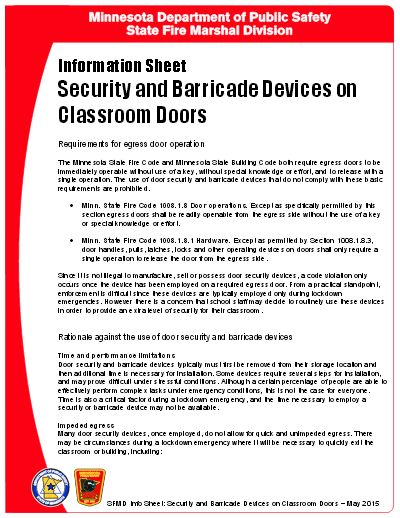I’ve been working with code officials, school districts, and others from various states on the classroom barricade device issue, and have shared a lot of information on the Schools page of my site. While the initial response to a state-specific law, proposed code change, or policy may not seem of importance to those in other states, that is not true. The debate that is taking place in Ohio, where politicians have submitted bills to override the current fire code requirements will likely set a precedent that affects the rest of the country. The incredibly vague law passed in Arkansas despite the testimony of the state fire marshal will hopefully motivate other states to take steps to protect the codes that ensure free egress, fire protection, and accessibility.
 I recently read the results of a survey conducted by the National Association of State Fire Marshals (NASFM), where each state fire marshal was asked what was happening in their state with regard to barricade devices. The response from the Minnesota State Fire Marshal stood out; their rationale for why they support the current model code requirements made a lot of sense. I asked if they had a version of this information that could be shared publicly, and it is now posted on their website. This document not only cites the code language that mandates free egress, it addresses the time and the operations required to install a barricade device, the threats caused by impeded egress, and the barrier to emergency personnel who have no way to access the classroom door when most barricade devices are installed.
I recently read the results of a survey conducted by the National Association of State Fire Marshals (NASFM), where each state fire marshal was asked what was happening in their state with regard to barricade devices. The response from the Minnesota State Fire Marshal stood out; their rationale for why they support the current model code requirements made a lot of sense. I asked if they had a version of this information that could be shared publicly, and it is now posted on their website. This document not only cites the code language that mandates free egress, it addresses the time and the operations required to install a barricade device, the threats caused by impeded egress, and the barrier to emergency personnel who have no way to access the classroom door when most barricade devices are installed.
This document does not technically apply to facilities located outside of Minnesota, but this reasonable insight from authorities with decades of fire safety experience can not be ignored. To me, this rationale was particularly powerful given the fact that Minnesota is the location of the 2005 school shooting at Red Lake High School, where a 16-year-old killed 7 people and wounded 5 others. Although the classroom doors were locked, the shooter broke the glass and gained access to the classroom by turning the inside lever. And yet, Minnesota has not responded to this incident by choosing inexpensive security over free egress, fire protection, and accessibility. There are glazing products and films that will delay access to the inside lever, and would be a much more logical solution than installing a barricade device.
Many code officials feel strongly about upholding current codes and making modifications via the code development process instead of allowing politicians to amend the codes. There are states that have taken a strong stance on this issue, sometimes adopting code language that goes above and beyond what is currently required by the model codes. Other states may be considering a change, and it’s important that all aspects of the situation are studied. If your state officials would benefit from reading the Minnesota rationale, the guidelines from the National Association of State Fire Marshals, or any other resources I’ve shared on this site, they are all available on the Schools tab (above).
You need to login or register to bookmark/favorite this content.





WELL SAID AND TO THE POINT!! THE GUY WHO WROTE THAT INFORMATION SHEET SHOULD BE WRITING CODE BOOKS SO THE REST OF US CAN EASILY UNDERSTAND THE RULES THAT WE ARE FORCED TO LIVE WITH IN OUR INDUSTRY.
I like this part;
“””Since it is not illegal to manufacture, sell or possess door security devices, a code violation only occurs once the device has been employed on a required egress door. From a practical standpoint, enforcement is difficult since these devices are typically employed only during lockdown emergencies. However there is a concern that school staff may decide to routinely use these devices in order to provide an extra level of security for their classroom.””””
The hardware stores can sell anything. Just how it is used makes it legal or illegal